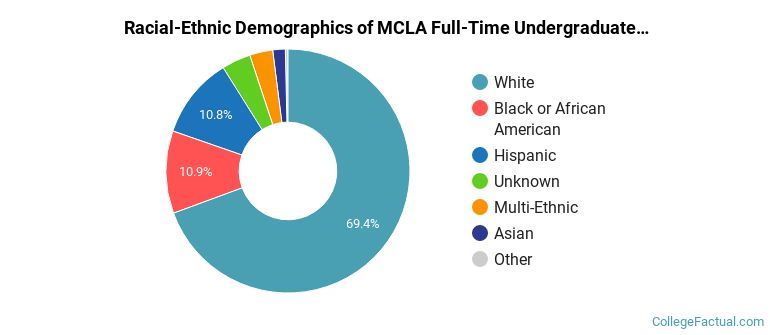 by our College Data Analytics Team
by our College Data Analytics TeamMCLA total enrollment is approximately 1,202 students. 931 are undergraduates and 49 are graduate students.
Male/Female Breakdown of Undergraduates
The full-time MCLA undergraduate population is made up of 61% women, and 39% men.

For the gender breakdown for all students, go here.
MCLA Racial/Ethnic Breakdown of Undergraduates

| Race/Ethnicity | Number |
|---|---|
| White | 661 |
| Hispanic | 111 |
| Black or African American | 87 |
| Unknown | 32 |
| Multi-Ethnic | 26 |
| Asian | 12 |
| Native Hawaiian or Pacific Islander | 1 |
| International | 0 |
See racial/ethnic breakdown for all students.
Male/Female Breakdown of Graduate Students
About 65% of full-time grad students are women, and 35% men.

For the gender breakdown for all students, go here.
MCLA Racial-Ethnic Breakdown of Graduate Students

| Race/Ethnicity | Number |
|---|---|
| White | 44 |
| Unknown | 3 |
| Hispanic | 2 |
| Asian | 0 |
| Black or African American | 0 |
| Native Hawaiian or Pacific Islander | 0 |
| International | 0 |
| Multi-Ethnic | 0 |
See racial/ethnic breakdown for all students.

| Race/Ethnicity | Number |
|---|---|
| White | 864 |
| Hispanic | 124 |
| Black or African American | 91 |
| Unknown | 78 |
| Multi-Ethnic | 29 |
| Asian | 13 |
| Native Hawaiian or Pacific Islander | 2 |
| International | 0 |

There are approximately 757 female students and 445 male students at MCLA.
MCLA ranks 1,033 out of 2,183 when it comes to geographic diversity.
33.85% of MCLA students come from out of state, and 0.61% come from out of the country.

The undergraduate student body is split among 14 states (may include Washington D.C.). Click on the map for more detail.

| State | Amount |
|---|---|
| Massachusetts | 215 |
| New York | 67 |
| Vermont | 17 |
| Connecticut | 13 |
| New Hampshire | 2 |
A traditional college student is defined as being between the ages of 18-21. At MCLA, 62.09% of students fall into that category, compared to the national average of 60%.

| Student Age Group | Amount |
|---|---|
| 18-19 | 515 |
| 20-21 | 471 |
| 22-24 | 209 |
| 35 and over | 178 |
| 25-29 | 113 |
| 30-34 | 62 |
| Under 18 | 0 |
Footnotes
*The racial-ethnic minorities count is calculated by taking the total number of students and subtracting white students, international students, and students whose race/ethnicity was unknown. This number is then divided by the total number of students at the school to obtain the racial-ethnic minorities percentage.
References
Department of Homeland Security Citizenship and Immigration Services
Image Credit: By Magicpiano under License
Find out how College Factual created their Diversity Rankings.